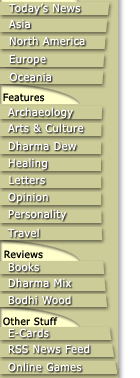 |
|||
|
|
Years of 'corpse meditation' now serving monks well
By Richard S. Ehrlich, THE WASHINGTON TIMES, Jan 3, 2004
PHUKET, Thailand -- The grim task of cremating thousands of tsunami victims has fallen to Thailand's saffron-robed monks, whose training requires them to stare at photos of decomposing bodies to better understand the transitory nature of life.
 The bloated and decomposed bodies still were being brought to Buddhist temples yesterday, in some cases carried from the jungle on the tusks of elephants that are being used to clear away debris.
The bloated and decomposed bodies still were being brought to Buddhist temples yesterday, in some cases carried from the jungle on the tusks of elephants that are being used to clear away debris.
Footage on government-run television showed the bodies being wrapped in plastic sheets and tied to the elephants' tusks, with ropes lashed to thick bamboo poles for additional support.
"I was talking to volunteers who were shifting bodies in a very badly hit area, Khao Lak, and into the temple," said Siripanyo Bhikkhu, a Buddhist monk who traveled to Phuket from his monastery in eastern Thailand.
Please read: Mindfulness of Death and Bodily Decay
"It's just way too much for people to handle. People are, within one or two days, becoming basically traumatized, operating very much on adrenaline, getting hardly any sleep," said the shaven-headed monk.
Nearly 5,000 corpses, about half of them foreigners, piled up so quickly after the tsunami on Dec. 26 that there was not enough morgue space to store them pending identification.
Thai officials piled many of the bodies outdoors at Buddhist temples and packed dry ice onto the shrouded mounds while medical personnel extracted DNA samples, which could be better preserved.
More than 2,400 Thai corpses were cremated according to traditional Buddhist rites, sometimes without being identified.
Thai officials rushed refrigerated trucks, formaldehyde, plastic body bags and additional personnel to Phuket, Khao Lak and other hard-hit zones, but they have not been able to fully cope with the thousands of dead.
Buddhist monks performing rites, cremations and after-death chants to chase away what they believe to be lingering ghosts also were working hard.
Years of special "corpse meditation" have helped each monk, or "bhikkhu," deal with the nightmarish tasks.
"Corpse contemplation, or corpse meditation, would be just literally [meditating on] a picture of a dead body, or a body at one of the actual stages of decomposition," said Siripanyo Bhikkhu, 34.
The macabre photographs, which many monks keep among their personal possessions, are publicly sold in religious shops throughout Thailand. They include news photos of people killed in accidents, suicides and fires, as well as pictures of corpses being dissected during autopsies.
Some photos show the grisly progression of decomposition of the human body.
The purpose of this traditional form of meditation is "simply to hold in your mind, very clearly, that when you look at a [living] person, you're seeing only the external aspect of that physical person."
"We just sort of live in denial of the fact that we have all these organs and bones and liquids and fluids," Siripanyo Bhikkhu said.
"We are obsessed with the externals. No one wants to see the internals. But we try to see them in an equal light, neither delighting nor being repelled by the attractive or the unattractive signs of the external or the internal," he said.
"It is very common with us to have [corpse meditation] pictures with us, to use them, or just to have in your hut, or have with you when you are eating, or just to look at and to contemplate," he said.
"It sounds incredibly gruesome and almost bizarre. But it is totally, totally normal and understood in Thailand," continued the monk, who sat cross-legged on the grass at Phuket City Hall, which has become a disaster-relief center.
"That's what monasteries are for: They remind us of the true nature of life, which is this impermanence and transitory nature."
Although the daily cremations of tsunami victims at temples along the west coast of Thailand evoke misery and despair for many witnesses, members of this Buddhist-majority society have a unique way of grieving.
"When we have cremations in our monasteries, basically they are open ? so, as the coffin burns, the corpse is then burning on a wooden pyre," Siripanyo Bhikkhu said.
"All the relatives, all the kids will go and view the corpse, will just stand around and watch granny burning," he said. "It's very, very normal. Very much at the heart of this place is impermanence."
|
|
||||
| Point
your feed reader to this location |
||||
|
|
||||
Latest
on the Asian
Tsunami Disaster
|
||||
|
|
||||
|
|
||||
 If you have a prayer for victims of the Asian Tsunami disaster, please Email to us |
||||
|
|
||||
| The
Buddhist Channel Articles Archive |
||||
|
|
||||
| Search the Channel | ||||
|
||||
|
|
||||
| About The Channel | Disclaimer |  |

